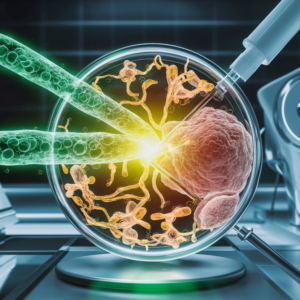PRP and Stem Cell Therapy: Breakthrough Treatments for Infertility

What is PRP Therapy?
Platelet-Rich Plasma (PRP) therapy is a cutting-edge procedure that uses the patient’s own blood to promote healing and tissue regeneration. The process involves drawing a small amount of blood, which is then processed to concentrate platelets. This platelet-rich plasma is injected back into the patient’s body at the site requiring treatment.
How Does PRP Therapy Work?
The secret behind PRP therapy lies in the platelets’ high concentration of growth factors. These factors can encourage tissue repair and regeneration, making PRP an effective solution for treating various conditions, including infertility. When applied to reproductive tissues, PRP therapy can:
- Enhance ovarian function
- Improve endometrial thickness
- Increase egg quality
- Stimulate follicular development
Understanding Stem Cell Therapy
Stem cell therapy involves the use of stem cells, which are unique cells capable of developing into various types of cells in the body. These cells can be harvested from the patient’s own body or from donated sources.
How Does Stem Cell Therapy Work?
Stem cells have the remarkable ability to differentiate and replace damaged or malfunctioning cells. In the context of infertility, stem cell therapy can:
- Regenerate ovarian tissue
- Improve sperm quality
- Facilitate the repair of reproductive organs
- Enhance overall reproductive health
Stem cell therapy offers a promising alternative for individuals facing various infertility issues, especially those who have not found success with traditional treatments.
Benefits of PRP and Stem Cell Therapy for Infertility
Utilizing PRP and stem cell therapy for infertility brings numerous benefits, including:
- Minimally invasive procedures: Both PRP and stem cell therapies are typically minimally invasive, involving injections rather than extensive surgeries.
- Natural solution: These therapies use the patient’s own cells, reducing the risk of adverse reactions or complications.
- Targeted treatment: The therapies can be precisely administered to the affected areas, offering targeted and effective treatment.
- Enhanced success rates: Studies and patient testimonials suggest higher success rates in achieving pregnancy with the use of these advanced treatments.
Procedure Overview
PRP Therapy Procedure
The PRP therapy process involves several steps:
- A blood sample is drawn from the patient.
- The sample is processed in a centrifuge to separate and concentrate the platelets.
- The platelet-rich plasma is then injected into the reproductive tissues needing treatment, such as the ovaries or endometrium.
Stem Cell Therapy Procedure
The stem cell therapy process may vary depending on the source of the stem cells:
- If using the patient’s own stem cells, a sample is collected from bone marrow or adipose (fat) tissue.
- The stem cells are isolated and concentrated in a lab.
- The prepared stem cells are then injected into the target areas, such as the ovaries or testes, to promote regeneration and repair.
Success Stories and Case Studies
The effectiveness of PRP and stem cell therapy is supported by numerous success stories and case studies. For instance:
- A 38-year-old woman with a history of IVF failures experienced improved ovarian function and achieved a successful pregnancy after undergoing PRP therapy.
- A couple with male infertility saw significant improvements in sperm quality and motility following stem cell therapy.
- A woman with thin endometrium had a thicker and more receptive endometrium post-PRP treatment, leading to a successful embryo implantation.
Conclusion
PRP and stem cell therapy represent groundbreaking advancements in the treatment of infertility. Both treatments offer hope to couples who’ve exhausted traditional methods, providing natural, minimally invasive, and effective solutions for enhancing reproductive health. If you or your partner are struggling with infertility, consider exploring these innovative options with a specialized healthcare provider.
As research and technology continue to evolve, the future looks promising for these regenerative therapies. Stay informed and consult with experts in the field to determine if PRP or stem cell therapy could be the key to overcoming infertility challenges.
“`